Artist Spotlight: Donna Campbell
January 27, 2021
For me there is nothing more satisfying than harvesting materials respectfully from the land, processing them and creating something beautiful. I admit, I am obsessed by raranga (Māori weaving). Making through raranga processes has been a source of cultural reclamation and grounding that I otherwise would not have experienced. Harvesting and preparing the materials is foundational to the making process. These processes are culturally significant as is the creation process itself.
I am often to referred to as a contemporary weaver, however my work could not be created if not for the ancestral knowledge that informs it. The transformation of plant to textile has always fascinated me and drawing on ancestral knowledge is a privilege.
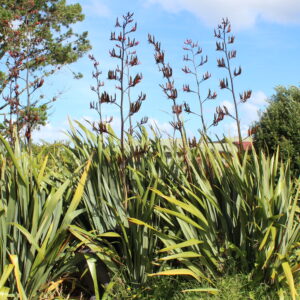
Harakeke Plantation.
Kete (basketry) form the basis of much of my work. Kete are created in a myriad of customary patterns, contemporary colours and shapes that use conventional techniques. My work extends these techniques to create sculptural garments for the body and representations of the body. To create these sculptural works I have to let go of the rules, only in knowing the rules can one truly let go.
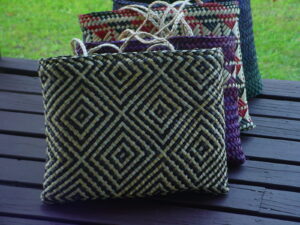
Donna Campbell Kete, harakeke, synthetic dyes, muka (harakeke fiber) handles.
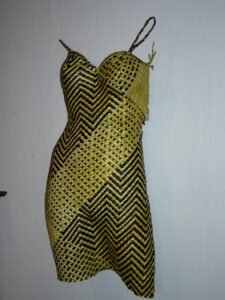
Donna Campbell Body Form (Reclaimed Kete series), reformed kete, harakeke, synthetic dyes.
Reclaimed Kete series
The basket to body works are deconstructed kete used to create body forms–I enjoy the process of unmaking and remaking. These works are possible because of the amazing sculptural quality of the plants, after processing weaving and drying. I relate to this as the memory embedded in the plant materials. These works are an exploration of the kete as container to the body as container, a cultural container. Many of these works were created from discarded baskets, opened up and reformed by reweaving undoing, subtracting whenu (strands) and adding whenu, whatever is needed at the time. This process is intuitive drawing on all my skills as a kairaranga.
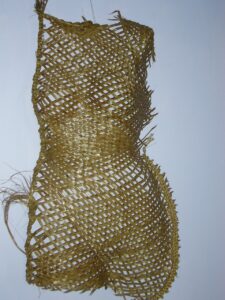
Donna Campbell Body Form (Reclaimed Kete series) openweave.
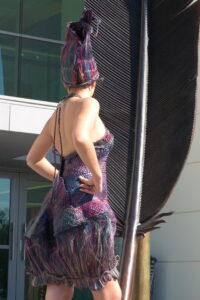
Donna Campbell Party Dress, harakeke, synthetic dyes.
I like to make work that challenges me in technique, form and design. The process is very much a dialogue between the material, Te Ao Māori (the Māori world) and me. It is a reciprocal relationship where the material responds, and the maker responds, at times vice versa, but always in an interchange. An example of the materials responding is when I am having difficulty with getting a design right. In these moments I need to slow down, and reflect on the state of mind I am in as to why there is struggle. I need to listen to the material, as it is demanding more attention.
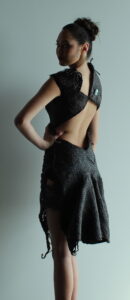
Donna Campbell Little Black Dress, harakeke, synthetic dyes, paua shell.
Most often than not I realize that I need to be more mindful, by honoring the challenge inherent within the material and bring humility to the process. These moments are in-between knowing and not knowing. Spaces of unknowing where an interchange arises and I am guided by what the material is willing to do with manipulation. It’s a process of letting things come, allowing the space for the work to manifest letting the material sing. I think of these spaces as states of unknowing, the in-between space of allowing the material to speak while at the same time thinking through the body that is making, a fluid state of moving between the material and oneself then back again. I call it listening to the material, allowing the material to stay true to itself, while at the same time manipulating the material to my vision. A kind of dance, that is for me the magic of the creative process. That’s what the creative process is about for me.
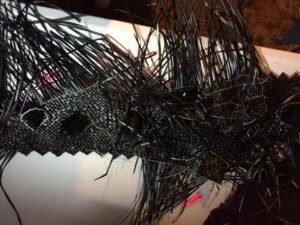
Donna Campbell Hinenuitepō I (in progress), the underneath of the cone textile.
An integral part of my creative process is a kind of ‘tearing down’, undoing weaving, reweaving, adding, subtracting are all integrated into the raranga (weave), and the whatu (off loom weaving) processes. At times undoing–because a mistake in the pattern needs to be put right, at other times, undoing–because the shape is not quite right. Or undoing–just because it needs to be undone. At times the finished work is not how I envisioned it…or does not have the qualities I was working towards. Sometimes works just don’t turn out. Even though they would not be exhibition worthy these pieces are still important in the development of ideas and techniques. At times even though I might feel the piece is not “working” I will persevere to move further into the technique I am practicing, oftentimes the work can be resolved focusing in this way. Even if the work is not resolved in this process there is always learning in the making. There can spaces of pure frustration when a work is not seemingly turning out the way I envisaged it. A kind of beautiful unease permeates these times, it dynamic and challenging. These spaces are where the learning of self, the understanding of self-arises. These are often the ceremonial spaces where karakia (cultural practice) and humbleness come to the fore.
Then when the work is created there is reflection, observation and critique brought to the work, in order to develop and build on what has gone before.
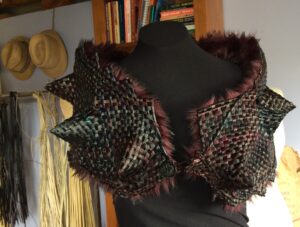
Donna Campbell Hinenuitepō I, harakeke, synthetic dyes, faux fur.
Recent works explore conical textile as wraps for the body. The conical textile is a challenge to create. There is absolutely guiding line as in conventional raranga and the intent is to connect the cones in a seamless way. The challenge is what motivates me to create. I am exploring the cone process in order for the materials to seem more assertive to the viewer and to myself as the maker. In much of my work I am concerned with the beauty of the materials, and the whakairo or patterns that enhance the weave. Sometimes I think that if the pieces are too beautiful the message behind them can be lost. My work strives to respect the cultural meanings embodied in the plants and the cultural practices, and make interesting work that pushes the boundaries of how raranga is related to as a contemporary art form.
– Donna Campbell



5 Comments
Hope Alcorn says
January 27, 2021 at 7:12 am
I just love her work!!! So beautiful. Love the materials and body forms especially. How can one see more of her work? Or purchase a kete fiber bag?
Hope Alcorn says
January 27, 2021 at 7:18 am
I just love her work!!! So beautiful. Love the materials and body forms especially.
Judy alexander says
January 28, 2021 at 1:02 am
What stunning work. I especially love the design of the woven dress.
Vivien says
March 10, 2021 at 2:28 pm
Such swoon-worthy art! I came here to read Donna's post after hearing her speak during the Aotearoa New Zealand Field Trip webinar. She spoke so eloquently. I was moved by her reverence of material and culture, and the way she's transforming both in her exciting and beautiful work. She's definitely on my list of artists to follow.
Archana Shastri says
May 9, 2021 at 5:47 am
Sensitive renderings in natural materials.
Related Blog Articles
aotearoa
SDA Book Club: “Crafting Aotearoa” by D Wood
aotearoa
Member Spotlight: Jeanette Verster
aotearoa
Artist Spotlight: Imogen Zino